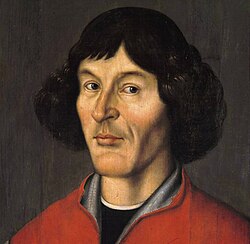Monetae cudendae ratio

"Monetae cudendae ratio" (also spelled "Monetæ cudendæ ratio"; English: "On the Minting of Coin" or "On the Striking of Coin"; sometimes, "Treatise on Money") is a paper on
.History

Copernicus' earliest draft of his essay in 1517 was entitled "De aestimatione monetae" ("On the Value of Coin"). He revised his original notes, while at
In the paper, Copernicus postulated the principle that "bad money drives out good",[4] which later came to be referred to as Gresham's law after a later describer, Sir Thomas Gresham. This phenomenon had been noted earlier by Nicole Oresme, but Copernicus rediscovered it independently. Gresham's law is still known in Poland and Central and Eastern Europe as the Copernicus-Gresham Law.[5]
In the same work, Copernicus also formulated an early version of the
"Monetae cudendae ratio" also draws a distinction between the
Copernicus' essay was republished in 1816 in the Polish capital, Warsaw, as Dissertatio de optima monetae cudendae ratione (Dissertation on the Optimal Minting of Coin), few copies of which survive.[7]
See also
References
- ^ Macleod, Henry Dunning (1896). The History of Economics. Bliss, Sands and Company. p. 451.
Copernicus Moneta.
- ^ ISBN 9780822309734.
- ^ Armitage, Angus (1963). "24" [The Diseases of Money]. The World of Copernicus. New American Library. pp. 89–91.
- ISBN 9780262263306.
- ^ Numismatic Literature. American Numismatic Society. 1972. p. 83.
- ISSN 0013-0117.
- ^ The American Historical Review. American Historical Association. 1926.
Journal
- GIGLIOTTI, JOSEPH (2009). "The Role of High Inflation in the Decline of Sixteenth Century Poland-Lithuania's Economy". The Polish Review. 54 (1): 61–76. JSTOR 25779788.
External links
- (in Latin) Nicolaus Copernicus: Monetae cudendae ratio Latin text at intratext.com
- (in Latin and French) MONETE CUDENDE RATIO per NICOLAUM.
- (in Latin)→(in English) MONETE CUDENDE RATIO per NICOLAUM.
